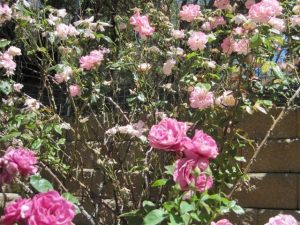The weather is finally looking like spring, which means it’s time to start thinking about the best ways to battle the insects and diseases that plague us gardeners once temperatures start to rise. These days, I go for simple, cheap and safe.
Here are a few favorites:
Water. Starting in spring when those pesky aphids start to appear, get in the habit of giving aphid-prone plants (can you spell r-o-s-e-s?) an all-over blast of water in the morning. A hard spray, including the undersides of leaves, knocks off and often kills soft-bodied insects on plant surfaces such as aphids, mites and thrips. The trick to this tactic is commitment; it won’t control the populations unless you do it every day. Spraying in the morning ensures plenty of time for the moisture to evaporate, which will help avoid molds and fungus.
Vegetable Oil. There are two things you can do with inexpensive veggie oils. First, fill an empty tuna can about three-quarters full, add a scrap of any kind of leftover meat, then set the can next to any plant that has been plagued by earwigs or slugs. They climb into the can and drown in the oil. The second use is in making homemade horticultural oil, which, when sprayed onto the plant when insects are present, basically smothers them—without leaving a toxic residue. Some gardeners also swear by homemade sprays as pest deterrents, mixing oil and water with ingredients like dish soap and cayenne pepper (for leaf-chewing insects) or garlic (for deterring deer). While these homemade concoctions are not proven scientifically, they are inexpensive, harmless tactics that just might help in combination with other practices.
(Tip: I’ve learned to give plants a shake before aiming the spray nozzle, to give any ladybugs and other beneficial insects on the plant a chance to escape the blast.)
Copper. Wrapping copper foil or flashing around tree, shrub, and woody perennial trunks and planter boxes will keep snails away for years. According to the UC Davis Integrated Pest Management (IPM) program, “It is believed that copper barriers are effective because the copper reacts with the slime that snails and slugs secrete, causing a disruption in their nervous system similar to an electric shock.” Another use of copper is in a “Bordeaux” mixture, which is a combination of copper sulfate, lime and water. It’s been used for decades as an effective fungicide and bactericide, especially on fruit and nut trees, vine fruits and ornamental plants. It’s used to prevent or control leaf curl, fire blight, black spot on roses and downy and powdery mildews, among other diseases. The mixture is best used in fall or winter when plants are dormant because it can damage leaves. “Fixed copper” fungicide sprays are another variant, but they don’t withstand winter rains as well as Bordeaux mixture.
To learn get more details about these, and other simple, environmentally friendly pest and disease controls, visit http://www.ipm.ucanr.edu, the UC Davis Integrated Pest Management website.
Rachel Oppedahl is a University of California Cooperative Extension Master Gardener of Tuolumne County.

